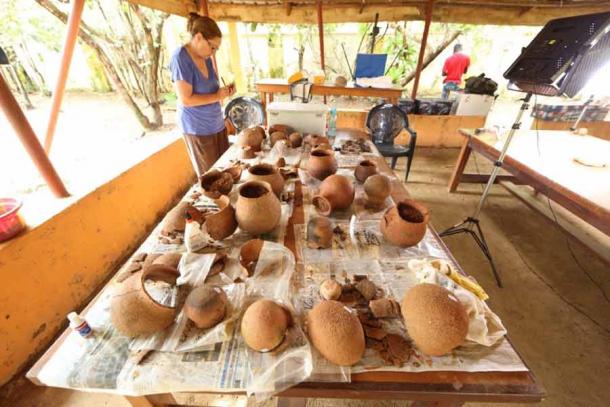
Nok Culture Pottery Reveals Honey Hunting Happened 3,500 Years Ago
Honey hunting is a practice of gathering honey from domesticated or wild bee colonies and hives. It is a practice for which evidence has been found in ancient history and it is still practiced by indigenous peoples all over the world as a method of survival. While there is evidence of honey hunting in rock paintings dating back 8,000 years, an innovative study published in the reputed journal Nature Communications has now found conclusive proof of ancient honey hunting in West Africa.
Led by two chemists and scholars from the University of Bristol in the United Kingdom and two archaeologists from Goethe University in Germany, the research project discovered evidence concealed within pottery fragments from 3,500 years ago at the time of the Nok civilization. “That honey was part of their daily menu was completely unexpected, and unique in the early history of Africa until now,” says Professor Peter Breunig from Goethe University, head of the archaeological project on the Nok culture.

As part of the research into Nok culture, the terracotta artifacts were cleaned and photographed at the Janjala research station. (Peter Breunig / Goethe University)
Evidence of Honey Hunting in Nok Civilization
Amazingly, beeswax residue was found in the pottery shards, traced to the Nok culture, an early Iron Age civilization located in what is modern-day Nigeria. They are found to have been around since 1500 BC, although they oddly vanished 2,000 years later around 500 AD. The greatest evidentiary remains from this ancient society is in the form of stunning terracotta sculptures discovered in 1928, in what is the oldest recorded figurative art anywhere in Africa. As an Iron Age civilization, they are also renowned for early iron production in West Africa, around the first millennium BC.
The Nok culture has been the subject of intense study by the Goethe University, part of a lengthy project funded by the German Research Foundation. This project commenced 12 years ago, initially assessing the terracotta sculptures. The research gradually expanded to encompass questions related to the dietary and food habits of the Nok people. As part of the project, more than 450 potsherds were analyzed.
- The Ancient Art of Honey Collecting On the Himalayan Cliffs of Nepal
- Honey Liquid Gold Of The Ancient World
One of the biggest questions for archaeologists and historians across the board, is understanding ancient food production and organization, such as whether a given culture was a hunter-gatherer-based society. Using a scientific method called gas chromatography, to assess fatty acids (or lipids) that are released into the vessels, a third of the shards revealed having high-molecular lipids, symptomatic of beeswax.
Dr. Julie Dunne from the University of Bristol, the first author of the study, explains that “this is a remarkable example for how biomolecular information from prehistoric pottery in combination with ethnographic data provides insight into the use of honey 3,500 years ago.” The honey was either processed by separation from the honeycombs, and then heated in the pots, or processed with the raw materials from other plants and animals. The exact science, and the purpose, remains unknown. The researchers haven’t been able to decipher if it was used for medicinal purposes or as part of their diet.

Example of modern-day African beehive. (Dunne et. al. / Nature)
Honey and its Use Throughout History
According to Mirage News, honey remains one of humanity’s oldest sweeteners, used today not just in food and fermentation, but also for its medicinal properties. It was (and is) also used for cosmetic and technological purposes. Beeswax, honey and pollen are sources of income around which small communities and local economies are organized all over the world, including in Africa, where honey is found scattered in hollow tree trunks and the undersides of branches and huts.
This discovery is also significant because of the brief mentions of honey and its uses in ancient history. A Bristol University press release explains that a lot of Paleolithic rock art, especially from Africa, displays ancient human exploitation of the honeybee dating back to between 40,000 and 8,000 years ago. The small bank of ethnographic and historical literature from the same period points to honey being used in wine and beer.
- Etruscans Transported Bees by Boat to Reach the Best Flowers!
- Beekeeping May Go Back to the Early Years of Agriculture, Up to 9,000 Years Ago
The study of the acidity of soils at the Nok sites was unfortunately unable to uncover the remains of organic elements, like plants and animals, so dietary habits remain a mystery. “Plant and animal remains from archaeological sites usually reveal only a small part of what prehistoric people had been eating,” highlights Professor Katharina Neumann from the Goethe University in Frankfurt. “Chemical residues of beeswax in potsherds opens up completely new perspectives for the history of resource exploitation and ancient diet.”
Top image: Researchers have analyzed pottery fragments to prove that honey hunting was part of daily life in the West African Nok culture 3,500 years ago. Source: Goethe University
By Sahir Pandey















